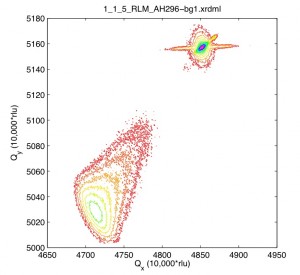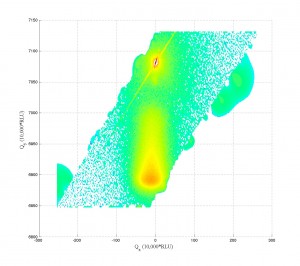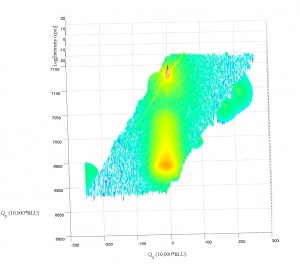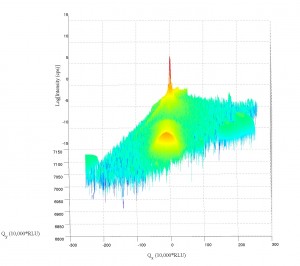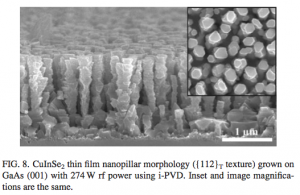 For a while now I’ve been dying to share some of the new nanostructures I’ve discovered during ion-assisted vapor deposition of CI(G)S thin films. My paper was published in the Journal of Applied Physics last fall (sorry for the blog outage over the winter-break). The paper is titled: “Nanostructured light-absorbing crystalline CuIn(1–x)GaxSe2 thin films grown through high flux, low energy ion irradiation;” http://dx.doi.org/10.1063/1.4823987. There are a lot of unanswered questions about the work that leaves me dreaming up different solutions to how these films are growing. Read More
For a while now I’ve been dying to share some of the new nanostructures I’ve discovered during ion-assisted vapor deposition of CI(G)S thin films. My paper was published in the Journal of Applied Physics last fall (sorry for the blog outage over the winter-break). The paper is titled: “Nanostructured light-absorbing crystalline CuIn(1–x)GaxSe2 thin films grown through high flux, low energy ion irradiation;” http://dx.doi.org/10.1063/1.4823987. There are a lot of unanswered questions about the work that leaves me dreaming up different solutions to how these films are growing. Read More
Tag Archives: Materials Science and Engineering
My New Nanostructured CI(G)S Light-Absorbing Thin Films Published in JAP
Update: Dow Corning Partners With Prof. Silver’s Adaptive Lens Program!
I had the pleasure of briefly meeting and listening to Dr. Gregg Zank (CTO- Dow Corning) this evening. Some very interesting work going on at Dow Corning! In particular, his discussion of a waterless powdered shampoo product for third world countries was quite amazing. It’s wonderful to imagine a waterless shampoo, let alone one that is distributed as a dry product in single use packets! Very interesting. It reminded me of another interesting humanitarian project that I’ve talked about before…
Read More
Finally- Qspace mapping success!
 I have no idea why this took so long, but I finally have the code to import and output various graphs of the reciprocal space maps (RLM or Q-space) taken using the Xpert Xray diffraction system. One of the difficulties in outputting the older data has been solved by our new line-scan detector system. The data is now taken in the more simple Omega-2Theta space instead of Omega-Omega2Theta space. With the help of Mauro Sardela, the fantastic research scientist who runs the XRD lab at the Materials Research Laboratory (FS-MRL), I’ve properly translated the data into Q-space using the same equations the Xpert Epitaxy software uses.
I have no idea why this took so long, but I finally have the code to import and output various graphs of the reciprocal space maps (RLM or Q-space) taken using the Xpert Xray diffraction system. One of the difficulties in outputting the older data has been solved by our new line-scan detector system. The data is now taken in the more simple Omega-2Theta space instead of Omega-Omega2Theta space. With the help of Mauro Sardela, the fantastic research scientist who runs the XRD lab at the Materials Research Laboratory (FS-MRL), I’ve properly translated the data into Q-space using the same equations the Xpert Epitaxy software uses.
Read More
More on XRD Q-space mapping.
After some new scans, it appears the XRDMLread.m function I talked about is doing a pretty good job of getting the 2-axis scans into MATLAB. I was able to alter the code to accept the standard Epitaxy software’s translation to Q-space. (In Epitaxy the default is R = 0.5 I believe.) So, the following image was imported with XRDMLread.m the plotted with the standard 2-d example from the author’s website. The code was altered to output 10000xRLU units the same as Epitaxy (Panalytical). I haven’t checked all the numbers, but it’s looking ok so far. Unfortunately the color-scale looses it’s meaning as far as intensity is concerned, it appears at first glance.
Working a bit with my old q-space map code, I’m able to accomplish the following:
Note the strange love-handles the data gains. I suspect this might be due to the Gridfit function (see MATLAB files repository) I used for regridding the data. Gridfit.m uses an extrapolant method. My suspicion is it is trying to fill out the square of the data matrix and is accomplishing relatively correct values for near-by-data that is outside the scanned range. I’ll try it again with regrid or something similar in the future when I have time.
If anyone knows where the current site for XRDMLread.m is, I’d love to link to it. It appears the site may be down (graduated student I suspect). You can obtain the wonderful XRDMLread.m function and examples on the XRDMLread.m website. For now, I have to wait until I hear from the authors before I can share the file. I also don’t yet trust my icky 3D code, so I prefer not to release that until I have things hashed out. Sorry!
I’m extremely happy that Panalytical has published their XRDML file format and that the makers of XRDML.m have released their .m files for MATLAB. In the past, when Philips had the Xpert systems, the data was stuck for the most part in proprietary data formats. [You could slice the data and output in ascii- but making that work was a pain- which is why I never released that previous code.] I’m much closer to the 3d plotting now, and hope to finish it up before the thesis (my primary work which is not this plotting) is published.
Wishing you luck in you research!
Software For Scientists: Engauge Digitizer
In the time I’ve been doing my research work at the Univ. of IL, I’ve come across a number of graphs from various past researchers, older papers, stuck on the side of machines (calibration curves), and even hand-drawn or chart-recorder graphs in my numerous projects. The only major problem with those graphs I’ve found is that they aren’t in a digital form for further use with other data (instrument response functions) or to include in your own work as a reference. So, what to do?
Well, there’s an easy solution. It’s not the perfect solution, as it’s a bit slow, I’ll get to that in a second, but it’s a great solution to the problem, and has worked for me a number of times now. To top it off, it’s open-source, donation-ware, and cross-platform: Engauge Digitizer (see post at LifeHacker.com). Don’t let the website and lack of recent updates deter you. Tools that can do what Engauge does are few and far between. So, it is definitely worth a try. Here’s an example of how I’ve used it just the other day (prompting this post- I’ve used it for years now, but the recent use reminded me I should share it with others). [click "More" to see an example use and learn more]
LaTeX Tip: NewCommand
For those friends of mine currently attempting to work in LaTeX to code Materials Science and Engineering related tidbits…
Here’s a quick tip. Tired of typing all those crazy math commands for your material’s name? Simply use a new command. Here’s are a couple examples…
%Simpler way of writing CUINSE2:
\newcommand{\cis}{CuInSe$_{2}$}
%Simpler way of writing CUINGASE2:
\newcommand{\cigs}{CuIn$_{(1-x)}$Ga$_{x}$Se$_{2}$}
%Simpler way of writing CUGASE2:
\newcommand{\cgs}{CuGaSe$_{2}$}
To see how this looks in compiled LaTeX output and another example, click “More”…
Read More
Filmetrics Rocks- iPod Touch 32g!!
Boston rocked: I’m writing this on a new iPod Touch! Filmetrics was running a drawing for those who brought samples to test! Big thankyou’s go out to Filmetrics and AVS. I will write more about the conference in a series of posts coming soon. I’m hoping everyone had a great week while I was gone.

